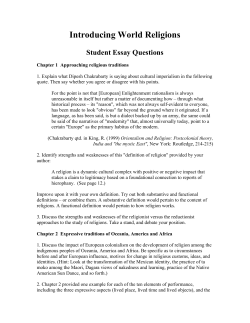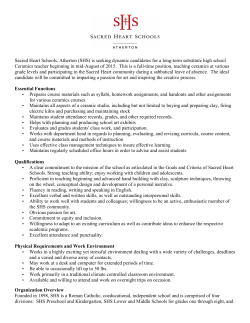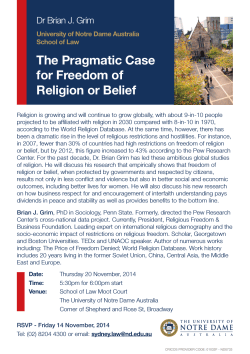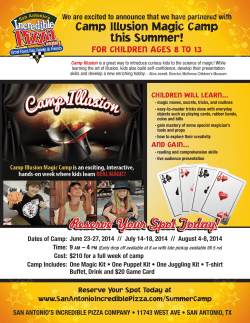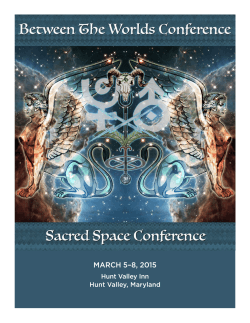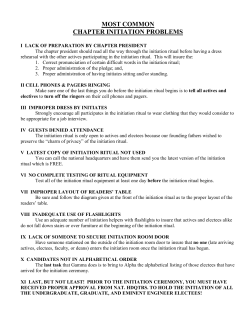
History of the Science of World Religions
History of the Science of World Religions A. Religion—from Latin “religio” 1. Originally seems to referred to as “fear” or reverence for the gods—later to the rites offered to them 2. Confusion as to where word originates a. “relegere”--to gather things together” or “to pass over things repeatedly” b. “religare”--to bind things together”—emphasize communal aspect—draws people into religious rites, practice and belief A. The study of religions seemingly originated with the Greeks 1. Herodotus—father of history—took seriously the chronology of the past 2. Epicurus—a radical critic of religion and sought to catalog and explain the sense of the sacred 3. Stoics—believed there was a common denominator of sacred behind all religion B. Romans studied religion 1. Cicero—concerned with the word “religion” and was first to use the term 2. Seneca, Tacitus, and Julius Caesar all interested in the study 3. After Christianity emerged study of different religions was neglected since the church was more concerned with its own mission and survival C. Confrontation with Islam 1. Islam rapid expansion 2. Crusades D. The Modern Mission Movement With William Carey in 1792 E. The New Empiricism and Rationalism 1. Deists and philosophers such as Hume, Rousseau, and Voltaire discussed the problem of “natural religion” 2. Max Mueller wrote an essay on comparative mythology—he found the origin of myths in natural phenomena Criteria for the Study of World Religions A. Objectivity—students of religion must observe facts as objectively as possible 1. One must consider sacred texts and historical manifestations of the faith 2. It is important not to pre-judge another religious perspective B. A Thorough Grounding 1. Must have knowledge of history, psychology, philosophy, sociology, and theology in order to come to the essence of different religions 2. Such facts are necessary for intelligent comparisons and discussions C. Proper Criteria One must have the responsibility to establish a criteria for judgment based on fact, not value judgments Distinguishing between fact and value 1. A factual judgment asserts that is or is so 2. A value judgment asserts that something ought to be The Study of Religion A. Animism Edward Tylor—founder of modern anthropology A type of consciousness in animate and inanimate objects Fear C. Rabbi Brown Anicent humanity was insecure because of the forces of nature Suggested Gen. 1:1 should have read “in the beginning was fear” Lucretius offered this as explanation of origin of religion “We fear what we do not know” B. Totemism—Durkheim Worship of ancestors Religion arose out of fear for loved ones Tribe was the family enlarged Religion is identified with society C. D. High God Revelation—Wilhelm Schmidt Rooted against evolution view of religion Believed most ancient people had a belief in a higher being Definitions of Religion A. Religion as a phenomenon looked on as universal—Eliade’s concept of the “sense of the sacred” B. Anti-Rationalistic Definitions 1. Lucretius—an anti-rational, coercive force 2. Reinanch—a sum of scruples which impede the free exercise of our faculties 3. Marx—a pathological manifestation of protective forces, deviation caused by ignorance of natural causes and their effects C. Intellectual Definition Max Mueller wrote that religion is a mental factor independent of sense and reason to apprehend the infinite in different names D. Emotional Definitions 1. Schleiermacher saw the essence of religion as an emotion and consists of feelings of absolute dependence 2. McTaggert said religion is best described as an emotion resting in conviction of harmony between ourselves and the universe at large E. Religion as Morality Immanuel Kant saw religion as the recognitions of our duties as divine commands, the driving force of the sacred is morality, e.g., tabu, holiness F. Psychological Definition William James said that religion comes from the feelings and experiences and individual people G. Religion as Ultimate Valuation—Paul Tillich’s ultimate concern 1. Ultimate concern has priority in the system of concerns which constitutes a personality or a culture—it gives meaning and purpose to human life 2. Ultimate concern is pervasive—spread over the totality of existence 3. Ultimate concern is concerned with the holy— Rudolph Otto saw holiness as a special and unique experience. He coined the phrase numinous, from Latin meaning divinity, god, or spirit—refers to a special feeling of aweness or fear 4. Ultimate concern has to do with the expression and communication of religious experience—religious experience takes place through symbolic words, objects, and actions 5. Ultimate Concern is both lived and celebrated--celebrated through liturgy and mythology—lived out in the religious expressions influencing all factors of life Three Types of Religious Experience A. Cosmic Religion—one in which there is found a plurality of religious objects or gods; it is polytheistic. The many gods are associated with nature and/or culture. Prehistoric and folk religions are examples of this type B. Acosmic Religion—one in which is found the religious object beyond the common secular world of nature and society—usually emphasizes the One. Hinduism and transcendental monism are examples C. Historical Religion—one in which is found the religious object beyond and within the common world—sees history as linear—examples are Judaism, Christanity, and Islam Religion of Pre-Historic Humanity Concept of religion is believed to have began in the Old Stone Age (Palaeolithic) with the Neanderthals (100,000-25,000 years ago) 1. Deliberate and meticulous care of burying dead, with ceremony 2. The dead were buried in a “fetal” position—a “return to the womb” A. 3. Example of burial in Monte Cicero (Italy) a. Bones of deer, horse, hyena, elephant, and lion were on the floor and heaped up around the walls in piles b. On the floor beneath the cranaium were two fractured metacarpals of an ox and of a deer c. The skull showed signs of having received a fatal blow on the right side of the temple d. At its base the portion connecting the braid with the spinal cord had been cut away after death, probably to extract the brain e. The site appeared be a place in which the body was deposited ceremonially in a cave used for ritual purposes as a sacred ossuary 4. Another example of a ritual burial is in Bavaria a. A nest of 27 human skulls were found in a group embedded in red ochre, the skulls looking westward b. A few yards away was a second identical group of six skulls—some of these the cervical vertebrae were still attached and from their condition the heads must have been severed from the body after death with flint knives c. Those skulls in the center were tightly packed together and crushed—it seems that they had been added one by one from time to time d. Twenty of the skulls were of children ornamented with snail shells; nine were of women with necklaces of deer teeth, and four were of adult males B. Cro-Magnons (25,000-10,000 years ago)—more developed 1. First “idols” found were of female deities—shows interest in fertility; the concept of the “mother goddess” beginning to appear as a fecundity motif 2. From drawings, it appears the concept of symphatic magic was being conceived 3. Throughout other burial sites, certain shells (cowrie) were shaped in the form of a portal through which a child enters the world 4. During this time there was a widespread custom of placing ochreous powder on the body: red was the color of life and placing the red ochre on the body suggests a belief in a “life to come” 5. One anthropologist believes the painting of the body with the red ochre was the first “mummification” and an attempt to make the body “servicable” again 6. Some burial spots could suggest that the living were making offerings to the dead out of a fear and awe of them C. Mesolithic Period (Middle Stone Age, 10,000-7,000 years ago 1. This age was a transitional age which saw the vanishing of the ice sheet and a gradual shift from nomadic to village life 2. In one grave site in Brittany were found a great ossuary with ten burial sites, including the remains of 23 individuals. a. The bodies were crouched in shallow trench caves near the hearths accompanied by implements, perforated shell necklaces, and braclets b. The bodies were covered with red ochre and stone slabs c. It appeared that the bodies were clothed where they were interred 3. In Denmark there was a continuation of extended burial in earth graves defined by a small ring of small stones around the body and covered with a large earth mound known as dyssers or dolmans D. The Neolithic (New Stone Age, 7000-3000 years ago 1. This age is characterized by several great changes a. Early forms of agriculture, with active tilling of the soil b. Domestication of animals and their gathering into flocks and herds c. Advances in the arts of pottery, plaiting, weaving, and sewing d. Establishment of settled communities with an accompanying growth of population e. The invention of the wheeled card f. The first surgery 2. Religion also being radically transformed a. The Mother Goddess or Great Goddess of earlier hunting culture became associated with creation and regeneration b. Female divine power went beyond the animal models of birthing and nurture to the watering, tending, and protecting of the whole world of vegetation c. Studies of Old Europe (Balkans) reveal a pantheon of mostly female deities subsequently obscured, but not fully displaced by later Indo-Aryan patriarchal and gender-polarized views. Generalizations of Tribal Religions A. Traditional—no written language exists B. Naturalistic framework of reference— biological drives C. Spontaneous—response to stimuli, irrational Broad Generalizations A. Primitive religion is monistic—no dualism B. A sense of absolute interdependence of all things C. Interdependence maintained by infallible rigid authority D. Religion serves to maintain social harmony and stability E. No opposites among tribal people—everything and everybody complementary Characteristics of Religion in Primal Cultures A. Awe before the Sacred 1. Rudolf Otto in The Ideal of the Holy, bases the experience of the holy upon an encounter with a mysterium tremendum et fascinosum, and found it in all religions—the degree of the sense of the awe or holy various tremendously with each group 2. In most primitive societies the sacred possesses a special significance and cannot be handled lightly 3. Objects and persons can have this “awe” within them B. Expressions of anxiety in ritual 1. When there is a sense of the sacred, anxiety occurs and will cause “action” 2. This “action” takes the form of special deeds and words 3. Such anxiety is the basis of all religious ritual C. Ritual and Expectancy 1. Some rituals are expectant in nature 2. They presuppose a causal efficacy 3. They are performed to bring health, offspring, productivity of the soil, fertility of cattle, et al 4. Other rites occur at specific times for specific purposes a. Rites of passage—connected with birth, name giving, initiation, betrothal, marriage, death, etc b. The elevation to tribal leadership or kingship D. Myth and Ritual 1. The making of myth is common in all human cultures 2. Myths help to answer questions as to the origin of actions or beliefs 3. Cosmogonic or “creation” myths help to explain the origin of existence 4. An etiological myth is one that explains how things have come to be as they are now 5. The quasi-historical myth is the elaboration of an original happening, usually involving a hero or pioneer figure E. Types of magic 1. Magic may be loosely defined as an endeavor through utterance of set words, or the performance of set acts, or both, to control or bend the powers of the world to one’s will 2. Sympathetic magic (James Frazer) takes an imitative form based upon analogy a. It assumes that look-alikes act alike, or, more significantly, that like influences or even produces like b. Thus, if one imitates the looks and actions of a person or an animal (or even a thundercloud), one can induce a like and desired action in the imitated being or object 3. Outcomes of magic are considered to be: a. Productive—Cro-Magnon hunting magic (painting) was a type of imitative magic b. Aversive—one can use magic to hurt one’s enemies by imitating a harmful act upon an image of a person c. Contagious—things conjoined and then separated still are connected—thus severed hair or fingernails retain a magical sympathy with the person to whom they belong 4. Methods of control of magic a. Fetishism—refers to any resort to a presumed power in inanimate objects— includes objects which have power innate in them b. Shamanism—refers to the conjuring of spirits into or out of human beings by one who is similarly spirit-possessed F. Prayer 1. Prayers in preliterate societies are generally formal and structured 2. Where the gods are anthropormorphic, formal prayers generally include elements found in more literate societies; namely, adoration, confession of wrongdoing, and promise of atonement, thanksgiving in grateful recognition of past favors, and supplication or petitions of a more or less specific kind G. Divination 1. A means to by-pass prayer 2. It aims at immediate knowledge of the intentions or dispositions of the spiritual powers 3. Usually there is a connection between divination and shamanism H. Belief in Mana (Used by Codrington) 1. Mana is a Melanesian term widely used to designate a widespread, although not universal, belief in occult force of indwelling supernatural power distinct from spirits 2. The term refers to an experienced presence of a powerful but silent force I. Animism 1. An acceptance that all sorts of motionless objects as well as living and moving creatures have souls or spirits in them 2. Identified with E. B. Tylor, who wrote that all nature is possessed, pervaded, crowded with spiritual beings J. Veneration and worship of powers 1. Worship can take three modes a. Sometimes an object itself is worshipped as living and active, heavily charged with mana b. Sometimes the object is nor worshipped for itself, but for the spirit or soul lodged in it c. Sometimes the object is a symbol of the reality which is worshipped 2. Veneration and awe are “short” of worship K. Recognition of a Supreme Being 1. Great debate as to whether primal peoples had a belief in a supreme being 2. It is rather common to find a belief in a deity up in the sky or at a great distance from the earth 3. Daily activities did not include such a high deity 4. The great deity usually was the creator of the more popular deities L. Taboo-Tabu 1. Taboos are prohibitions applied to things, persons, and actions because they are considered sacred, dangerous, or socially forbidden 2. Many taboos are due to fear based on mana; others may reflect the dread of pollution M. Purification rites 1. Ceremonies of purification and cleansing are due to the belief of taboos or the impurity of a certain person or object 2. In some cases, purification rites are used for the motive of purifying oneself for future ritual 3. Purification rites may take the form of fasting, abstention from sex, ablutions, et al N. Sacrifices and gifts 1. Sacrifice usually entails the giving up or destruction (e.g., burning) of something, animate or inanimate, human, animal, or vegetable in order to cause it to pass from human possession to that of the divine 2. Original sacrifices seem to have involved animal and/or human sacrifices, because the spirits as well as humans need the vitality and strength present in life and blood 3. Sacrifice may be performed to seek reconciliation with a divinity 4. Sacrifice may be performed to placate the gods; thus considered to be propitiatory O. Attitudes toward the dead 1. In many ancient societies, there developed a view that the dead may cause injury to the living 2. Thus, some kind of actions or words may be performed to prevent such interference P. Totemism 1. A very common characteristic of primal religions recognize the existence of a more or less intimate relationship between certain human groups or particular individuals and classes or species of animals, plant, or inanimate object in nature 2. This recognition results in special social grouping and special rituals unique to that social grouping 3. If an animal is the totem, the group is forbidden to eat the animal except in special cases 4. By eating the animal, the group takes on the power of that particular animal African Religion I. No way to really discuss as one category since differences are so great— we can look at a few recurring themes A. Transcendence 1. Names and expressions of divinities vary greatly 2. But there does seem to be a general belief that there exists a kind of a supreme being who has control over the lesser spirits 3. The first observations that African religion was simply forms of primitive polytheism does not seem to bear out 4. The supreme being is described in various ways—as a beneficent being, a father or mother, or as a holy god 5. Popular religion seems to be polytheistic; these beings seem to be representatives or servants of the higher god 6. Like most religions, there are creation stories B. Stages on Life’s way—one’s life is dominated by rituals—rites of passage 1.Birth—children are important— naming ceremonies is important ceremony, accomplished in a variety of ways 2. Initiation—the coming of age, assumption of responsibilities of adulthood 3. Marriage—very important and intricate 4. Death—serious and somewhat fearful experience; there is general belief in a life after death; reincarnation believed by some C. Religious roles 1. Includes prophets, shamans, sacred kings, traditional medicine men 2. They have means of foreseeing the future 3. Oracles are important 4. The priest is important; uses established ritual forms which relate human life to transcendent life 5. King is important feature Native American Religion A. Like African religions, there is great variety 1. Differences between gatherers and farmers 2. The latter celebrate the cycle of the agricultural year 3. Many hunter-gatherers have stories of a transformer of trickster who set things in motion 4. For farmers the creator is not a person, but a power in the sky B. Recurring Themes 1. Transcendence a. There exists in all persons and objects a mystifying spirit—called mana by Melanesians b. Many do not have concept of a single high god c. Paul Radin notes two aspects of this high god (a) the supreme deity is just and rational but remote (b) the transformer who is not always fair, but actively intervene in human life; there also exists great number of other spirits—good and bad C. Stages on Life’s way 1. Birth—naming ceremony is extremely important 2. Initiation a. A vision quest for boys and sometimes for girls b. Usually accomplished by sending them into wilderness, usually sees a supernatural visitor, that becomes major divinity of the person 3. Marriage—intricate—no single pattern—many see in women a mysterious power 4. Death—usually takes on form of fear and avoidance—contact with corpse leads to separation or isolation D. Religious roles—emphasis on shaman, medicine man and priest—priests lead in established rituals, no vision necessary
© Copyright 2025

